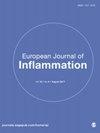Clinical analysis of diagnosis and treatment of necrotizing fasciitis
IF 0.8
4区 医学
Q4 IMMUNOLOGY
引用次数: 1
Abstract
It is difficult to diagnose necrotizing fasciitis early. In addition, untimely or incorrect treatment worsens the disease, which may then develop into severe necrotizing fasciitis. A retrospective analysis of the clinical data of 35 patients with severe necrotizing fasciitis admitted to the Burn Department of Gansu Provincial Hospital from 1 January 2015, to 1 January 2020, and the etiology, causes and diagnosis of their aggravated conditions was performed. Thirty cases were directly or indirectly related to trauma, 4 cases were pressure sores caused by long-term paraplegia, and 1 case was from mosquito bites on the left side of the chest. The preliminary diagnosis of 24 patients was unclear, and these cases were misdiagnosed as cellulitis or skin infections; 11 patients were diagnosed at the early stage, but due to the incorrect treatment or failure of timely treatment, their condition was further aggravated and developed into critical necrotizing fasciitis. 1. The diagnosis of necrotizing fasciitis mainly depends on clinical manifestations, and early diagnosis is key; 2. When the patient has local trauma accompanied by local inflammation, fever or hypothermia, necrotizing fasciitis should be highly suspected, and a differential diagnosis should be made between necrotizing fasciitis and cellulitis. The affected tissue should be thoroughly debrided and drained to avoid necrosis spreading to the distal limb along the fascial space. 3. Necrotizing fasciitis should be treated with systemic comprehensive treatment, rational use of antibiotics, correction of water and electrolyte disturbance, early active and thorough debridement and effective wound closure.坏死性筋膜炎诊治的临床分析
坏死性筋膜炎很难早期诊断。此外,不及时或不正确的治疗会使疾病恶化,进而可能发展为严重的坏死性筋膜炎。对2015年1月1日至2020年1月31日甘肃省医院烧伤科收治的35例严重坏死性筋膜炎患者的临床数据进行回顾性分析,并对其病情加重的病因、原因和诊断进行分析。30例与创伤直接或间接相关,4例为长期截瘫引起的压疮,1例为胸部左侧蚊虫叮咬。24例患者的初步诊断不明确,这些病例被误诊为蜂窝组织炎或皮肤感染;11名患者在早期被确诊,但由于治疗不当或未能及时治疗,病情进一步加重,发展为危重坏死性筋膜炎。1.坏死性筋膜炎的诊断主要取决于临床表现,早期诊断是关键;2.当患者有局部创伤并伴有局部炎症、发烧或体温过低时,应高度怀疑坏死性筋膜炎,并应在坏死性筋筋膜炎和蜂窝组织炎之间进行鉴别诊断。受影响的组织应彻底清理和引流,以避免坏死沿着筋膜间隙扩散到远端肢体。3.坏死性筋膜炎应采取系统综合治疗,合理使用抗生素,纠正水电解质紊乱,早期积极彻底清创,有效闭合伤口。
本文章由计算机程序翻译,如有差异,请以英文原文为准。
求助全文
约1分钟内获得全文
求助全文
来源期刊
CiteScore
0.90
自引率
0.00%
发文量
54
审稿时长
15 weeks
期刊介绍:
European Journal of Inflammation is a multidisciplinary, peer-reviewed, open access journal covering a wide range of topics in inflammation, including immunology, pathology, pharmacology and related general experimental and clinical research.

 求助内容:
求助内容: 应助结果提醒方式:
应助结果提醒方式:


